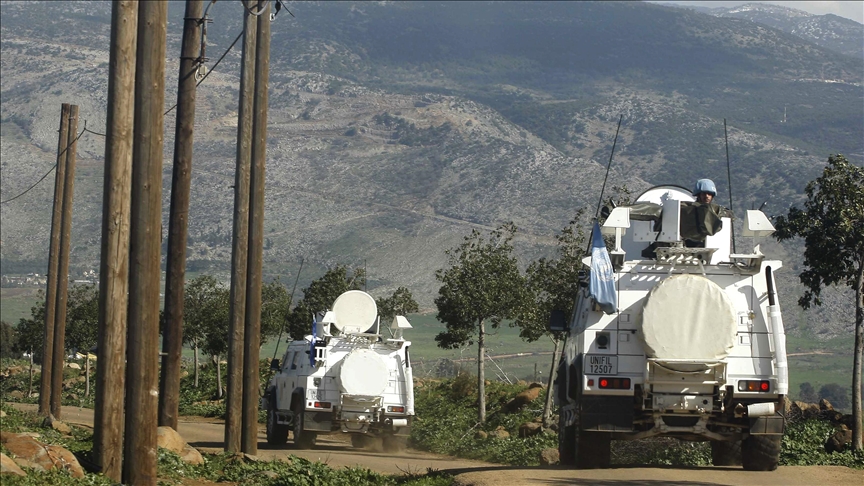Tensions mount between Hezbollah, Israel at Lebanese border
BEIRUT
Tensions have escalated in recent months between Israel and the Hezbollah movement on Lebanon’s southern border over Tel Aviv’s full occupation and annexation of the northern part of the village of Ghajar in the Golan Heights.
Hezbollah leader Sayyed Hassan Nasrallah spoke Wednesday, saying that Lebanon would not give up the village to Israel.
In a televised speech to commemorate the 17th anniversary of the 34-day war between Lebanon and Israel in 2006, he said that “liberating Ghajar is the responsibility of the Lebanese people, state and resistance.”
He added that Israel had finished building a wall incorporating the northern part of Ghajar and turned it into a tourist area.

The Lebanese Foreign Ministry warned in a statement on July 4 that Israel was seeking to expand the occupation zone in clear violation of United Nations Security Council Resolution 1701, which banned entry to the northern part of Ghajar.
Hezbollah said on July 7 that Israel had occupied the entire village.
Lebanese Foreign Minister Abdallah Bou Habib reiterated on July 10 that Israel should withdraw from Ghajar.
The next day, the Lebanese government complained to the UN that Israel had completely occupied the village.
Lebanese Prime Minister Najib Mikati also announced that Israel was responsible for 18 violations on the border.
Hezbollah border tents
Prior to these developments, Hezbollah had set up tents in Shebaa Farms and the Kfar Shouba hills close to the border at the beginning of June.
The Shebaa Farms area has been under Israeli occupation since 1967.
Israel sent a message to the Lebanese government regarding Hezbollah’s tents via the US Embassy in Beirut, according to Al-Akhbar, a Lebanese daily newspaper known for its closeness to Hezbollah.
Israel did not want to enter into a military conflict with Lebanon because of the tents, according to the newspaper.
Israel also conveyed a request for removing the tents to the Lebanese government through the United Nations Interim Peacekeeping Force (UNIFIL) on the border.
In response, Lebanese Foreign Minister Bou Habib said on July 10 that UNIFIL conveyed Israel’s request for the removal of the tents.
“They should withdraw from the village first. It is part of Lebanese territory,” he added.
Israel to occupy village: Hezbollah
“Israel plans to completely occupy the village of Ghajar in response to the tents that Hezbollah put on the border,” said Nasrallah.
“For about a year, Israel has been making preparations to build a fence around this area.
“The entire international community has remained silent,” he added.
The land border between Lebanon and Israel is clear and does not need to be redrawn, Nasrallah said.
The Hezbollah leader said the problem stems from Israel’s occupation of certain areas of Lebanon.
Lebanese Prime Minister Najib Mikati, meanwhile, told the Beirut-based daily Nida al-Watan on July 11 that they were ready to draw the land border with Israel, known as the UNIFIL-controlled Blue Line.
There is a 120-kilometer (75-mile) border line between Lebanon and Israel under UNIFIL control.
The two countries reached an agreement in October 2022 on the demarcation of a disputed maritime border.
Tensions remain high on the Lebanese-Israeli border, 17 years after Israel and Hezbollah fought a 34-day war in which more than 1,200 Lebanese — mostly civilians — were killed. Some 160 Israelis, mostly soldiers, were also killed in the conflict.
Military tensions in the border region resumed in April with the launch of 30 rockets from Lebanese territory towards Israel.
Following the Six-Day War with Syria in 1967, Israel occupied Ghajar in the Golan Heights. It then unilaterally annexed the area in 1981.
Israeli forces withdrew from Lebanon in 2000, including the northern part of Ghajar, but retained control of its southern area.
It later recaptured the northern part of the village after six years of conflict with Hezbollah. Despite a decision by Tel Aviv in November 2010 to once again withdraw, the de facto occupation by the Israeli army continued.
The Lebanese village remained a military zone for 22 years, with Israel opening it to Israeli tourists in November last year.
Around 2,000 people, mostly Alevis, reside in the village.
*Writing by Ikram Kouachi
Anadolu Agency website contains only a portion of the news stories offered to subscribers in the AA News Broadcasting System (HAS), and in summarized form. Please contact us for subscription options.

